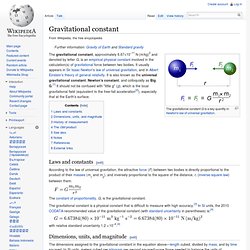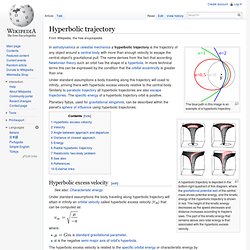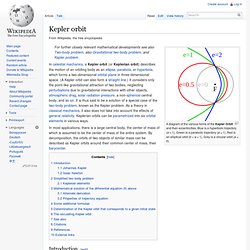

Gravitational constant. The gravitational constant, approximately 6.67×10−11 N·(m/kg)2 and denoted by letter G, is an empirical physical constant involved in the calculation(s) of gravitational force between two bodies.

It usually appears in Sir Isaac Newton's law of universal gravitation, and in Albert Einstein's theory of general relativity. It is also known as the universal gravitational constant, Newton's constant, and colloquially as Big G.[1] It should not be confused with "little g" (g), which is the local gravitational field (equivalent to the free-fall acceleration[2]), especially that at the Earth's surface. Laws and constants[edit] According to the law of universal gravitation, the attractive force (F) between two bodies is directly proportional to the product of their masses (m1 and m2), and inversely proportional to the square of the distance, r, (inverse-square law) between them: The constant of proportionality, G, is the gravitational constant. with relative standard uncertainty 1.2×10−4.[4] .
And. Hyperbolic trajectory. The blue path in this image is an example of a hyperbolic trajectory A hyperbolic trajectory is depicted in the bottom-right quadrant of this diagram, where the gravitational potential well of the central mass shows potential energy, and the kinetic energy of the hyperbolic trajectory is shown in red.

The height of the kinetic energy decreases as the speed decreases and distance increases according to Kepler's laws. The part of the kinetic energy that remains above zero total energy is that associated with the hyperbolic excess velocity. In astrodynamics or celestial mechanics a hyperbolic trajectory is the trajectory of any object around a central body with more than enough velocity to escape the central object's gravitational pull. The name derives from the fact that according Newtonian theory such an orbit has the shape of a hyperbola. Hyperbolic excess velocity[edit] ) that can be computed as: where: is commonly used in planning interplanetary missions. Velocity[edit] and Energy[edit] Kepler orbit.
A diagram of the various forms of the Kepler Orbit and their eccentricities.

Blue is a hyperbolic trajectory (e > 1). Green is a parabolic trajectory (e = 1). Red is an elliptical orbit (0 < e < 1). Grey is a circular orbit (e = 0). For further closely relevant mathematical developments see also Two-body problem, also Gravitational two-body problem, and Kepler problem. Introduction[edit] From ancient times until the 16th and 17th centuries, the motions of the planets were believed to follow perfectly circular geocentric paths as taught by the ancient Greek philosophers Aristotle and Ptolemy. Johannes Kepler[edit] In 1601, Johannes Kepler acquired the extensive, meticulous observations of the planets made by Tycho Brahe. More generally, the path of an object undergoing Keplerian motion may also follow a parabola or a hyperbola, which, along with ellipses, belong to a group of curves known as conic sections. Where: Alternately, the equation can be expressed as: Where Isaac Newton[edit] 1. 2.
And.